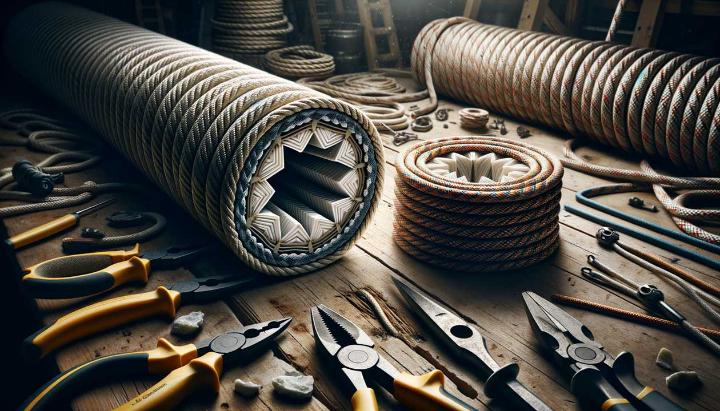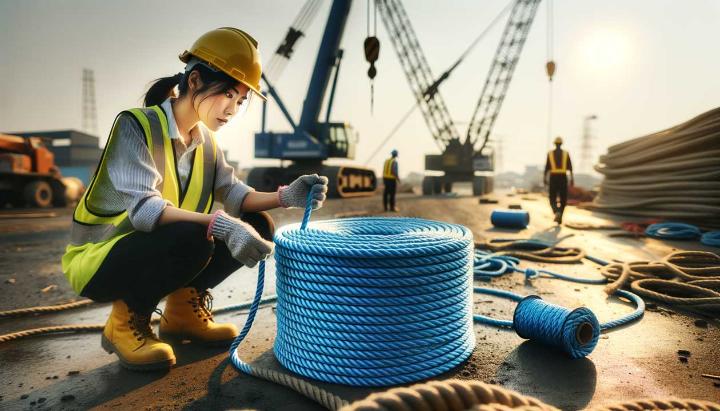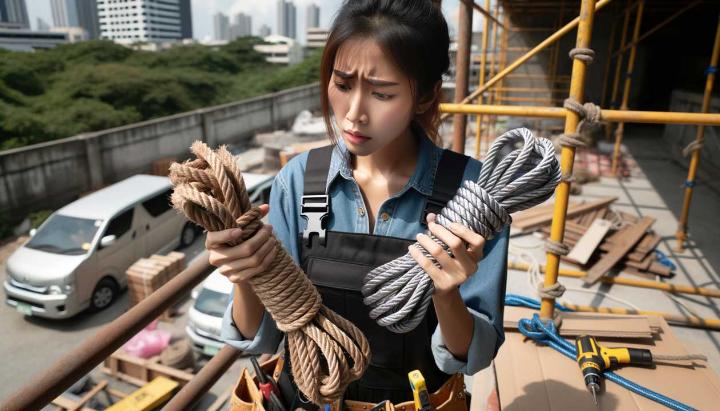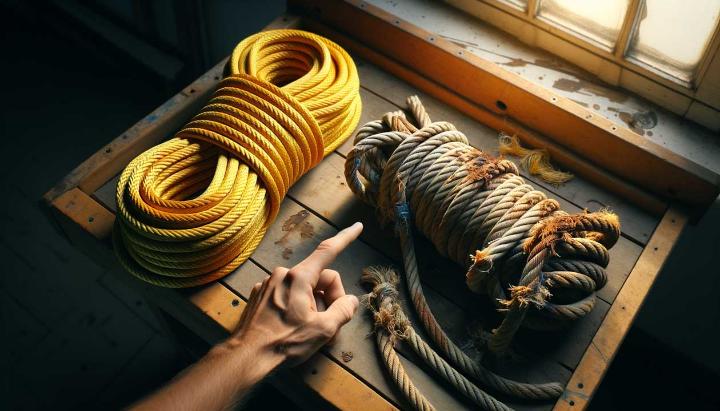Imagine dangling from a cliff face, your life literally hanging by a thread. In that heart-stopping moment, would you trust just any rope to keep you safe? When it comes to safety ropes, the difference between life and death often lies in the details of their construction. Today, we're diving deep into the world of double braid safety ropes - the unsung heroes of countless high-risk operations.
At iRopes, we've seen firsthand how the right safety rope can make all the difference. From offshore oil rigs to treacherous rescue missions, our double braid safety ropes have become the go-to choice for professionals who refuse to compromise on safety. But what makes these ropes so special, and why should you care?
In this essential guide, we'll unravel the mysteries of safety rope construction, with a laser focus on the superior double braid design. We'll explore how these ropes outperform traditional 3-strand ropes in strength, durability, and versatility. Whether you're a seasoned professional or just starting to explore the world of safety equipment, this guide will equip you with the knowledge to make informed decisions that could one day save a life - perhaps even your own.
So, are you ready to learn why double braid safety ropes are revolutionising secure operations across industries? Let's dive in and discover how these remarkable ropes are setting new standards in safety and performance.
Understanding Safety Rope Construction and Materials
When it comes to safety ropes, the devil's in the details. As someone who's spent years working with various rope types, I can tell you that understanding the construction and materials used is crucial for ensuring your safety in any operation. Let's dive into the world of safety ropes, with a focus on the superior double braid construction.
Types of Safety Rope Construction
Safety ropes come in various constructions, but the gold standard is undoubtedly the kernmantle design. Picture this: a strong inner core (the kern) surrounded by a protective outer sheath (the mantle). It's like the rope equivalent of a Thermos - robust on the inside, protective on the outside.

Double braid safety ropes take this concept a step further. They feature two interwoven braids, creating a rope that's incredibly strong and flexible. In contrast, the traditional 3-strand rope, while still used in some applications, doesn't quite match up in terms of strength and handling.
Key Materials Used in Safety Ropes
Now, let's talk materials. Gone are the days of natural fibre ropes for safety applications. Today, it's all about synthetic materials. Why? They offer superior strength, durability, and resistance to the elements.
- Nylon: The superhero of rope materials. It's strong, stretchy, and absorbs energy well - perfect for fall protection.
- Polyester: Less stretch than nylon, but excellent resistance to UV degradation and chemicals. Ideal for long-term outdoor use.
- Polypropylene: Lightweight and water-resistant, but not as strong as nylon or polyester. Often used in water rescue scenarios.
Each material has its strengths, and the choice depends on the specific application. For instance, I once worked on a project where we needed ropes for a coastal rescue operation. We opted for polyester due to its excellent UV resistance and ability to withstand saltwater exposure.
Remember, the best safety rope is the one that's right for your specific needs. Always consult with a rope specialist or safety professional when selecting ropes for critical applications.
Understanding these construction methods and materials is just the first step in choosing the right safety rope. In the next section, we'll explore the benefits and applications of double braid safety ropes in more detail. But before we move on, what's your experience with different types of safety ropes? Have you noticed a difference in performance between double braid and 3-strand ropes?
Benefits and Applications of Double Braid Safety Rope
When it comes to safety ropes, double braid construction stands head and shoulders above the rest. As someone who's worked with various rope types across multiple industries, I can confidently say that double braid safety ropes offer a unique combination of strength, durability, and versatility that's hard to beat.
Unmatched Strength and Durability
Double braid safety ropes are like the superheroes of the rope world. Their construction involves two interwoven braids, creating a rope that's not just strong, but incredibly resilient. Let me break it down for you:
- Superior strength-to-weight ratio: Double braid ropes pack a punch without the bulk, making them easier to handle without compromising on strength.
- Exceptional abrasion resistance: These ropes can take a beating and keep on going, perfect for rugged work environments.
- UV protection: Many double braid ropes come with built-in UV resistance, ensuring they don't degrade quickly under harsh sunlight.
I once worked on a construction project where we switched from traditional 3-strand ropes to double braid polyester ropes. The difference was night and day - our equipment operators reported less rope wear and tear, even after months of heavy use.

Versatile Applications in Safety-Critical Environments
The beauty of double braid safety ropes lies in their versatility. They're not just strong; they're incredibly adaptable to various industries and applications. Here's where they really shine:
- Marine operations: From mooring lines to rescue operations, double braid ropes excel in wet conditions.
- Construction and industrial use: Their low stretch properties make them ideal for controlled lifting and rigging applications.
- Rescue and emergency services: When lives are on the line, the reliability of double braid ropes is invaluable.
I remember a particularly challenging rescue operation where we had to extract a climber from a steep cliff face. The low stretch and high strength of our double braid safety rope allowed for precise control during the descent and ascent, potentially saving a life.
While double braid ropes offer superior performance in many applications, it's crucial to select the right rope for your specific needs. Always consult with safety professionals and follow industry guidelines when choosing and using safety ropes.
Have you ever used double braid safety ropes in your work? I'd love to hear about your experiences and how they compared to other rope types you've used. Drop a comment below and let's discuss the pros and cons you've encountered in real-world applications!
Selecting the Right Safety Line Rope
When it comes to safety operations, choosing the right safety line rope can mean the difference between life and death. As someone who's spent years in the industry, I can't stress enough how crucial this decision is. Let's dive into the key factors you need to consider to ensure you're making the best choice for your specific needs.
Types of Safety Ropes and Their Properties
Safety ropes come in various constructions, each with its own set of properties. While we've primarily focused on double braid ropes, it's essential to understand the full spectrum:
- Static kernmantle ropes: These are the workhorses of the safety world, ideal for life lines due to their low stretch and high strength.
- Dynamic ropes: Designed to absorb energy, these are crucial for fall arrest systems but less suitable for general safety lines.
- 3-strand ropes: While not as advanced as kernmantle ropes, they still have their place in certain applications due to their affordability and ease of splicing.
Double braid ropes, which we've discussed earlier, offer a fantastic balance of strength, durability, and handling. They're my go-to choice for most safety applications.
NFPA Standards for Life Safety Ropes
When selecting a safety line rope, adherence to industry standards is non-negotiable. The National Fire Protection Association (NFPA) Standard 1983 is the gold standard for life safety ropes. It sets strict guidelines for:
- Elongation limits: Ensuring the rope doesn't stretch too much under load, maintaining stability during rescue operations.
- Minimum breaking strength: Guaranteeing the rope can withstand the forces it may encounter in real-world scenarios.
- Performance under various conditions: Testing ropes for resistance to abrasion, UV degradation, and chemical exposure.
Always ensure your safety line rope meets or exceeds NFPA 1983 standards. Your life could depend on it!
Factors to Consider When Choosing a Safety Line
Selecting the right safety line rope involves weighing several critical factors:
- Rope diameter: Affects strength and handling. Larger diameters generally offer higher breaking strengths but can be more challenging to manage.
- Material: Nylon is the most common choice due to its excellent strength-to-weight ratio and energy absorption properties. Polyester is a close second, offering better UV resistance.
- Intended use: Consider the specific application. Are you using it for fall protection, rescue operations, or general safety lines?
- Environmental conditions: Will the rope be exposed to harsh sunlight, chemicals, or abrasive surfaces?
In my experience, it's always better to err on the side of caution. I once worked on a project where we initially chose a rope based solely on cost. Midway through, we realized it wasn't up to the task and had to replace it with a higher-quality option. The lesson? Invest in quality from the start - it's always worth it.

Remember, the best safety line rope is the one that meets all your specific requirements while adhering to industry standards. Don't hesitate to consult with rope specialists or safety professionals when making your choice. Your life - or someone else's - may depend on it.
What's been your experience with selecting safety line ropes? Have you ever had to make a tough decision between different types? Share your thoughts in the comments below - your insights could help others make informed decisions!
Essential Safety Rope Maintenance and Usage Guidelines
As someone who's worked with safety ropes for years, I can't stress enough how crucial proper maintenance and usage are. Your rope is your lifeline, and treating it with care ensures it'll be there for you when you need it most. Let's dive into some essential guidelines that'll keep your double braid safety ropes in top-notch condition.
Proper Storage and Cleaning Techniques for Safety Ropes
Storing your safety rope correctly is the first step in extending its lifespan. I've seen too many ropes deteriorate prematurely due to poor storage practices. Here's what you need to know:
- Cool and dry environment: Store your rope in a cool, dry place away from direct sunlight. UV radiation can weaken synthetic fibres over time.
- Ventilation is key: Ensure good air circulation to prevent mould growth, especially if your rope has been exposed to moisture.
- Avoid chemical exposure: Keep your rope away from harsh chemicals, including cleaning agents and fuel.
When it comes to cleaning, gentle is the way to go. I remember once using a harsh detergent on a rope, thinking it would get it extra clean. Big mistake! The rope's strength was compromised, and we had to retire it early. Here's the proper cleaning process:
- Rinse the rope with cool water to remove loose dirt.
- Use a mild, rope-specific detergent or pure soap flakes.
- Gently work the soap through the rope by hand.
- Rinse thoroughly until the water runs clear.
- Air dry the rope away from direct heat or sunlight.
Never use a washing machine or dryer for your safety ropes. The agitation and heat can seriously damage the rope's structure.
Inspecting and Retiring Safety Ropes: Best Practices
Regular inspections are crucial for maintaining the integrity of your safety ropes. I make it a habit to inspect my ropes before and after each use. Here's what to look out for:
- Visible damage: Check for cuts, fraying, or abrasions along the entire length of the rope.
- Inconsistent diameter: Feel for any lumps, soft spots, or changes in rope thickness.
- Discoloration: Look for any unusual colour changes, which could indicate chemical contamination or UV damage.
- Core condition: For double braid ropes, ensure the core isn't visible through the sheath.
Knowing when to retire a rope is just as important as proper maintenance. I've had to make tough calls on retiring ropes that looked "okay" but had reached their recommended lifespan. Here are some guidelines:
- Age: Most manufacturers recommend retiring ropes after 5-7 years, even if they appear in good condition.
- Usage intensity: Heavy use can shorten a rope's lifespan significantly.
- Severe impacts: Any rope that's experienced a severe fall or shock load should be retired immediately.
- When in doubt, throw it out: If you're unsure about a rope's condition, it's always better to err on the side of caution.

Remember, these maintenance practices apply to all types of safety ropes, including double braid and 3-strand constructions. However, double braid ropes often have specific care instructions due to their unique construction, so always refer to the manufacturer's guidelines.
By following these essential maintenance and usage guidelines, you're not just prolonging the life of your safety rope – you're investing in your own safety and the safety of those around you. Have you encountered any challenges in maintaining your safety ropes? Share your experiences in the comments below!
For more insights on high-quality ropes, feel free to explore the Top Benefits of Double Braided Polyester Ropes in Yachting. These ropes are engineered for strength and designed for performance.
Understanding the importance and benefits of safety rope construction, this guide focuses on why double braid safety ropes are superior for secure operations. Highlighting the enhanced strength, durability, and flexibility of double braid ropes compared to traditional 3 strand rope, the post delves into key factors to consider when choosing a safety line rope, including diameter, length, and material. Emphasising regular inspection and proper maintenance, it ensures that your safety equipment stays reliable. Prioritise safety and invest in high-quality, certified safety ropes to secure your operations.
Get Your Customised Safety Rope Solutions
Fill out the form above to discuss your specific safety rope needs with our experts. Your safety is our top priority, and we're here to provide the best rope solutions tailored to your requirements.